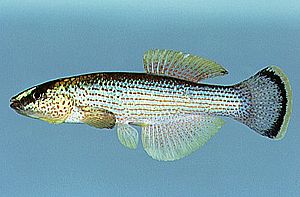Northern studfish facts for kids
Quick facts for kids Northern studfish |
|
|---|---|
 |
|
| Conservation status | |
| Scientific classification | |
| Synonyms | |
|
Poecilia catenata Storer, 1846 |
The northern studfish (Fundulus catenatus) is the biggest type of killifish. It lives naturally in the south-central parts of the United States.
Contents
What the Northern Studfish Looks Like
Adult northern studfish are usually about 3 to 6 inches (7.6 to 15 cm) long. Male and female studfish look different from each other. This is called sexual dimorphism.
During their breeding season, male studfish have bright orange spots in rows on a light blue body. Their tails have a bright orange edge, followed by a dark band. Female studfish are more camouflaged. They are usually beige and olive colors.
Their bodies are long and thin. They do not have a lateral line, which is a sensory organ many fish have. Their fins, both the anal fin and the dorsal fin, are large and do not have spines.
Where the Northern Studfish Lives
Northern studfish are found in many rivers and streams across the south-central United States. They live in parts of Indiana, Kentucky, Tennessee, Alabama, and Mississippi. West of the Mississippi River, they are found in areas like Ozark and Ouachita uplands. This includes central and southern Missouri, southeastern Kansas, eastern Oklahoma, and southern Arkansas. They also live in some parts of southwestern Mississippi and in the Gulf Slope drainage rivers.
Sometimes, people use these fish as live bait or release them from aquariums. This has caused the northern studfish to spread to new places where they did not originally live.
Northern Studfish Life and Habitat
Northern studfish lay eggs. They like clear, shallow pools and rocky creeks. These places usually have a mix of sand and gravel on the bottom. They also prefer water that flows slowly and steadily.
Male studfish do not build nests. Instead, they pick out a small area and protect it from other fish. Females lay between 28 and 245 eggs at one time. After laying their eggs, the parents do not take care of their young.
Their main food is insects that they catch from the water's surface. They have also been known to eat snails.
Protecting the Northern Studfish
In the state of Tennessee, the northern studfish is listed as a threatened species. This means their numbers are getting lower. There are several reasons for this decline.
One reason is the introduction of other fish species that are not native to the area, like the mosquitofish. These new fish can be aggressive. Another reason is human activity that harms water quality. This includes pollution and changes to their habitat. Northern studfish need clear water to survive. So, controlling how much dirt and mud gets into the water is very important.
Current efforts to protect them include planting trees and plants along riverbanks. This helps to make the banks stronger and stops dirt and pollution from farms and construction sites from washing into the water.
See also
 In Spanish: Fundulus catenatus para niños
In Spanish: Fundulus catenatus para niños


